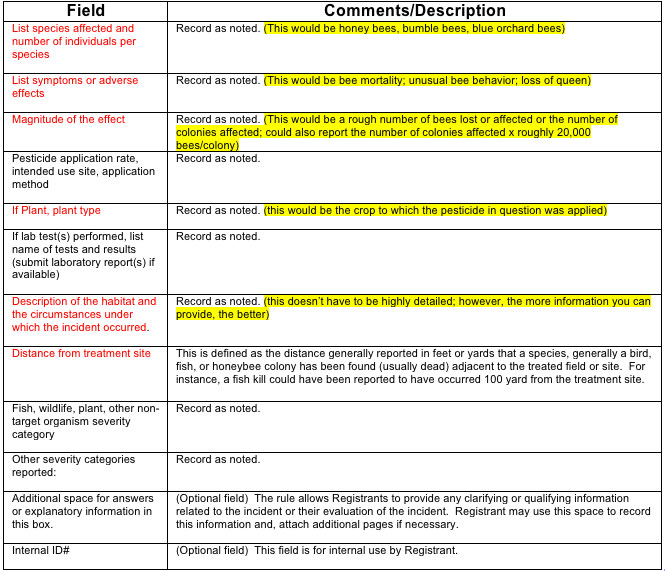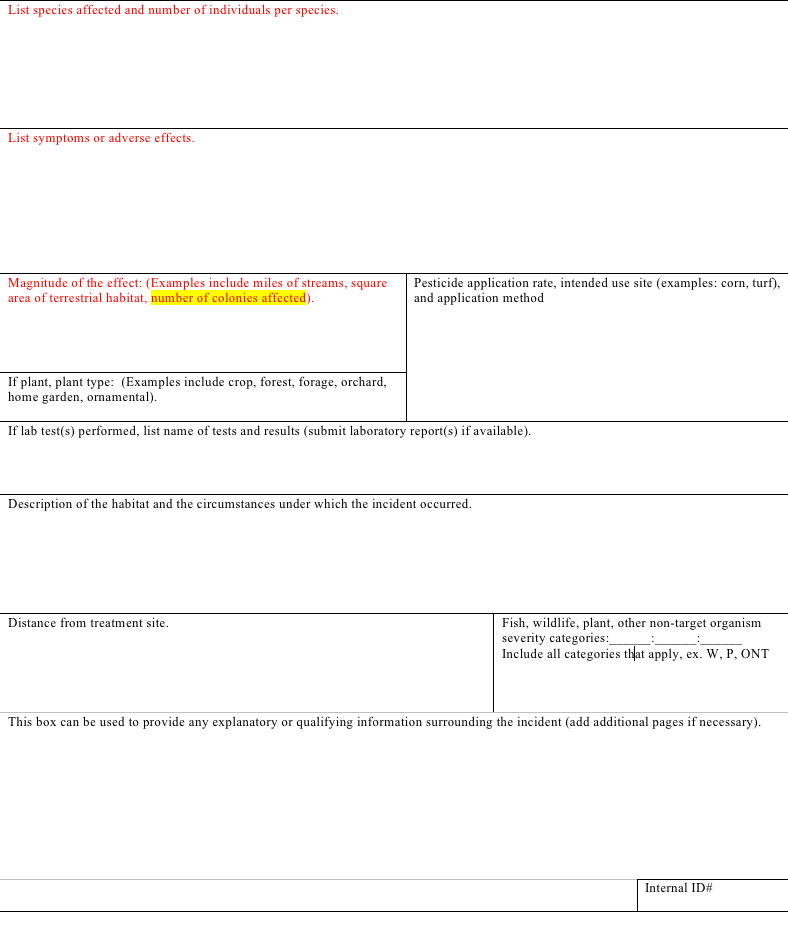Pesticide Incident Reporting
Pesticide Incident Reporting
Randy Oliver
ScientificBeekeeping.com
First Published in ABJ in May 2012
The EPA needs to know if pesticides are causing “incidents” involving honey bee mortality. It is important for beekeepers to bring such incidents to the EPA’s attention, or they won’t know that there are problems!
If your colonies experience a pesticide incident, please rule out any other possible causes first! In many suspected pesticide kills, the fact is that poor nutrition/starvation, viruses, nosema, overdosing with mite treatments, or poor varroa management were the true cause of mortality.
On the other hand, if you see a large number of twitching bees dying in front of the hives, or actually observed spraying or dusting causing bee mortality, then you should take action!
The first agency to contact would be your State Lead Agency or bee inspector (your ag commissioner can direct you) to see whether they will help you in a timely manner. If that fails, the EPA is trying to make it easier for beekeepers to file incident reports directly–see the Jan 8,2013 update below for your first step (https://www.epa.gov/pollinator-protection/report-bee-kills or calling Robert Miller).
Update June 9, 2013
(Broken Link!) http://blog.beeculture.com/wp-content/uploads/2013/06/bee-inspection-guide.pdf
(Broken Link!) Guidance for Issuing Federal EPA Inspector Credentials to Authorize Employees of State/Tribal Governments to Conduct Inspections on Behalf of EPA (PDF) (97 pp, 1.4MB)
(Broken Link!) National Policy on the Role of the EPA Inspector in Providing Compliance Assistance During Inspection (PDF) (17 pp, 190K)
(Broken Link!) The Role of the EPA Inspector in Providing Compliance Assistance (PDF) (72 pp, 370K)Biosecurity Guidance (PDF) (31 pp, 843K)
(Broken Link!) Digital Camera Guidance for EPA Civil Inspections and Investigations (PDF) (14 pp, 588K)
Update Jan 8,2013
Here are your options, straight from the horse’s mouth:
Randy,
I read your website for pesticide incident reporting and wanted to provide additional information to you. Contacting the states concerning bee incidents is essential, but we would also like beekeepers to report incidents at our NPIC site:http://npic.orst.edu/
I appreciate your help in providing this information to the beekeepers.
Sincerely,
Robert A. Miller
Ecological Incident Coordinator
Environmental Fate and Effects Division
Office of Pesticide Programs
United States – Environmental Protection Agency
1200 Pennsylvania Avenue, N.W., Washington D.C.
Mail Code: 7507P
Phone: (703) 347-8012
Previous update:
Randy,
There are at least four options for beekeepers to report beekill incidents. The preferred method is to notify the state lead agency, typically the state’s Department of Agriculture. States have primacy for making sure that pesticide labels are followed/enforced; reporting incidents to the state lead agency will better ensure that the incident will be properly investigated. Typically, samples will be collected by the state to conduct residue analyses and the results of these analyses can provide evidence whether a particular pesticide may have been a factor in the beekill.
Another option is to report the beekill to the pesticide manufacturer whose product is suspected. Contact information for reporting incidents is typically on the product label. Under the Federal Insecticide, Fungicide and Rodenticide Act (FIFRA), registrants are then required to report such incidents to EPA. Registrants will frequently investigate incident reports and may collect samples for residue analyses.
Because beekeepers have on occasion indicated that their incident reports are ignored by state and local officials, beekeepers have the option of reporting an incident through the National Pesticide Information Center (NPIC) website: http://npic.orst.edu/reportprob.html#env . The website contains the information outlined above, but it also provides the option of entering incident information directly into the NPIC. The NPIC contains a number of data entry fields for describing the incident; however, some beekeepers find the data entry form daunting.
A fourth option is to report beekills through https://www.epa.gov/pollinator-protection/report-bee-kills. I monitor this site and I will typically contact the individual by phone to get additional details regarding the loss. The difficulty with the last two reporting methods is that the incidents are not thoroughly investigated. As a result no residue data are available to link a particular pesticide with the loss [should that be the cause].
Attached please find a list of data which EPA typically includes in incident reports. If beekeepers are unable to complete all of the fields, they should provide what they can.
(See attached file: Incident Data.docx)
Tom Steeger
Thomas Steeger, Ph.D.
Senior Science Advisor
Environmental Fate and Effects Division
U. S. Environmental Protection Agency (MC 7507P)
Ariel Rios Building
1200 Pennsylvania Ave., NW
Washington DC 20460
(703) 305-5444 (Office)
(703) 305-6019 (FAX)
Industry’s Voluntary 6(a)(2) Incident Reporting Forms & Guidance Documents
August 4, 1998
KEY TO DATA FIELDS ON INDIVIDUAL INCIDENT FORMS
Fish, Wildlife, Plant or Other Non-Target Organism Incidents
Addendum
(See attached form)

Voluntary Industry Reporting Form for 6(a)(2) Adverse Effects Incident Information
Provide all known, required information. If required data field information is unknown, designate as such in appropriate area.

Voluntary Industry Reporting Form for 6(a)(2) Incident Information Involving Fish, Wildlife, Plants or Other Non-Target Org.
Provide all known, required information. If required data field information is unknown, designate as such in appropriate area.




